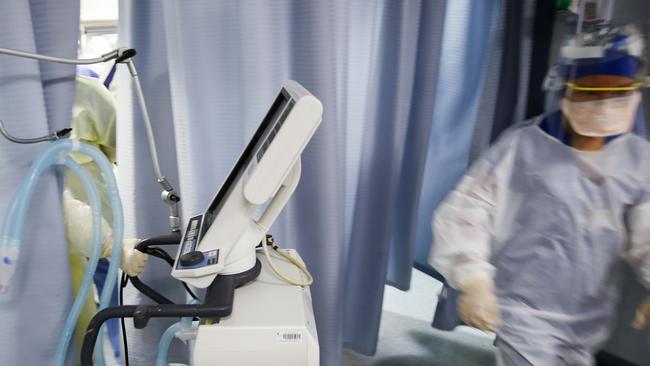Coronavirus: ‘Happy’ victims defy medical knowledge
It is another medical mystery of the coronavirus pandemic.

It is another medical mystery of the coronavirus pandemic: large numbers of COVID-19 patients arrive at hospitals with blood-oxygen levels so low they should be unconscious or on the verge of organ failure. Instead they are awake, talking and not struggling to breathe.
Although nobody is quite sure what about the coronavirus causes these patients to react this way, they are rapidly changing how many doctors are treating the disease. Instead of rushing to put such patients on mechanical ventilators for fear of them suddenly getting worse and dying, some doctors are holding off on the invasive treatment, believing many of these patients will do fine without them.
Pre-COVID, doctors looking to boost a patient’s blood-oxygen levels would often turn first to less invasive methods of support such as CPAP or BiPAP machines that push air into a patient’s airway through a face mask, or high-flow nasal cannulas — prongs that blow heated, humidified oxygen into a patient’s nostrils. If that didn’t work, physicians would use mechanical ventilators.
Then people with COVID-19 began showing up at the hospital with rarely seen, ultra-low blood-oxygen levels. Even for those who weren’t struggling to breathe, doctors were concerned that patients’ conditions could suddenly worsen, which with COVID-19 could swiftly turn deadly. So they often intubated sooner.
“In the past, you’d see these kinds of oxygen levels, and your brain would intuit all these other things,” said Scott Weingart, chief of emergency critical care in the department of emergency medicine at Stony Brook Hospital in New York State. “For instance, you’d assume the patient’s lungs must be so bad that if we don’t intubate now, they might crap out.”
Doctors have dubbed these patients “happy hypoxemics”, a reference to the paradox of abnormally low levels of oxygen found in their blood combined with an ability to breathe relatively easily.
In recent weeks, doctors at Stony Brook Hospital have used ventilators less on these patients, turning instead to the CPAP or BiPAP machines or high-flow nasal cannulas.
Dr Weingart remembers one of his first such patients in March — a 42-year-old man with blood-oxygen levels so low he should have been unconscious. Instead, he was sitting up, smiling and talking. He was breathing quickly, but seemed fine otherwise. Dr Weingart and his team used a high-flow nasal cannula; the patient was never put on a ventilator and was discharged in a week.
Several other doctors said they were having success with similar, simpler approaches. That, in turn, is reducing demand for ventilators.
In Britain, 58.8 per cent of COVID patients on invasive breathing support had died as of May 7, the National Health Service said.
The Wall Street Journal



To join the conversation, please log in. Don't have an account? Register
Join the conversation, you are commenting as Logout